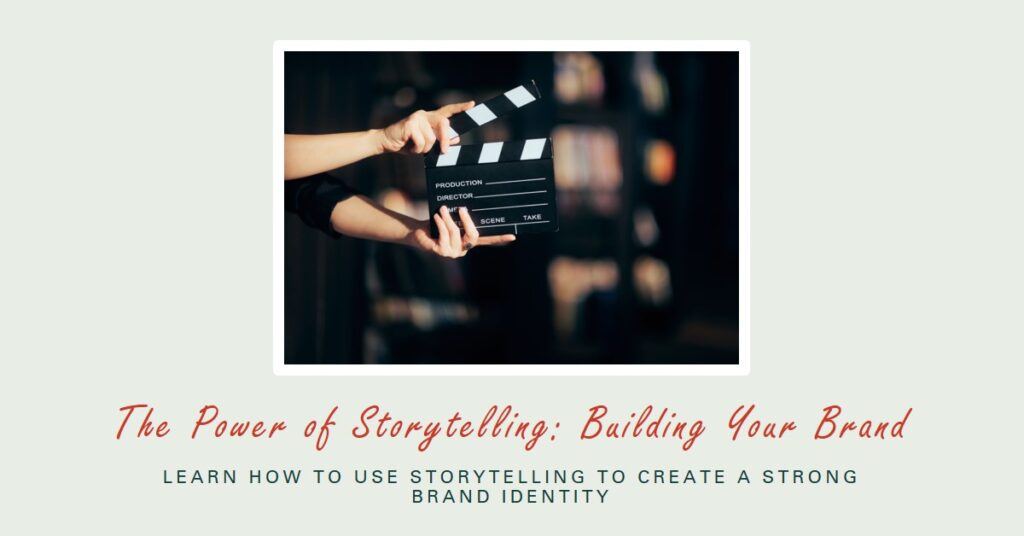- What is Brand Storytelling?
- Elements of a Compelling Brand Story
- Benefits of Brand Storytelling
- Examples of Successful Brand Storytelling Campaigns
- How to Create a Brand Storytelling Strategy
- Case Studies: Brands That Mastered the Art of Brand Storytelling
- Conclusion
- References
- Frequently Asked Questions
Brand Storytelling is a crucial tool in marketing. It helps brands emotionally connect with their audience. Through stories, brands can show their values, mission, and products. It goes beyond just promoting them. It creates a deeper connection with consumers.
Brand Storytelling is also unique in that it creates an immersive experience. Videos, social media posts, and blogs transport viewers to a different world. It helps build lasting relationships.
Take Nike’s “Just Do It” campaign. It’s become a symbol of motivation and perseverance. It tells stories of athletes overcoming adversity to achieve greatness. This campaign has been very successful.
What is Brand Storytelling?
To fully understand brand storytelling, dive into the importance behind this powerful tool. Discover the impact it can have on connecting with your audience and building brand loyalty. Explore the sub-sections on the significance of brand storytelling and its role in captivating your target market.The Importance of Brand Storytelling
Brand storytelling is a vital part of setting up a brand’s identity and connecting with customers. It has a major role in expressing the values and feelings that come with the brand, finally affecting customer beliefs and loyalty.
- 1. Brand storytelling helps make an emotional association between the brand and its target market. By telling interesting stories, brands can access the strength of emotions to draw in customers more profoundly.
- 2. It makes the brand differ from its rivals. With so many options available, people are attracted to brands with unique tales. A carefully crafted brand story makes the brand stand out and makes it memorable for customers.
- Finally, brand storytelling boosts brand recall. When customers relate to a brand’s story, they are more likely to remember it and share it with others. This word-of-mouth promotion can significantly enlarge brand visibility and reach.
Apart from these points, successful brand storytelling also grows trust amongst customers by humanizing the brand and showing its genuineness. By aligning their narratives with their core values, brands prove their credibility and make stronger ties with their target market.
Pro tip: Keep your brand story the same on all platforms and touchpoints to strengthen its effect on customer thoughts. Crafting an impressive brand story is like playing with Legos – you need the correct pieces to fit together and construct something unforgettable.
Elements of a Compelling Brand Story
To effectively convey the essence of a compelling brand story, dive into the elements that make it engaging and captivating. Explore how character/protagonist, conflict/challenge, and resolution/solution work together to create a narrative that resonates with your audience.Character/Protagonist
Meet Lisa, our 32-year-old protagonist! She’s an entrepreneur who values creativity, resilience, and empathy. Her actions and interactions with customers demonstrate these qualities.
To create a compelling brand story, consider these tips:
- Make sure the character reflects your target audience’s aspirations and struggles. This builds relatability and emotional engagement.
- Give the character a clear purpose that drives the story forward. This gives both the protagonist and audience a sense of purpose.
In addition, develop a backstory for your character to add layers to their journey. This helps explain their motivations and experiences. Lastly, let the protagonist transform or grow. This adds interest to the narrative and lets your audience relate to their own journeys.
By following these suggestions when crafting your protagonist, you can create a captivating story that resonates with your target market. An engaging character is the anchor of your brand story, helping build connections with your audience. Finally, don’t forget to include a conflict – it’s the ultimate attention-grabber!
Conflict/Challenge
Creating a captivating brand story requires a conflict or challenge. This tension grips an audience’s attention. The conflict could be internal or external. It must be portrayed to build an emotional connection.
For example, a start-up faced intense competition. Their struggle to stand out and gain recognition was the central conflict. Despite the odds, they innovated and persevered.
This real-life story shows how a challenge can shape a brand’s identity. Relatable moments of triumph can inspire and motivate.
Solution? Rebrand and a little black magic!
Resolution/Solution
For brands, finding a resolution or solution to challenges is crucial. Here are three tips to keep in mind:
- Identify the core problem that your brand story will address. This will set the foundation for your resolution.
- Craft a unique solution that aligns with your brand’s values and purpose. Make sure it resonates with your target audience emotionally.
- Communicate the resolution effectively using storytelling techniques – such as vivid images, relatable characters, and engaging narratives. This will make an impression on your audience.
To add depth to your resolution/solution, consider human emotions. Highlight how your brand story’s resolution connects to people’s desires, fears, or aspirations. Doing this authentically will create a deeper connection with your audience.
An example of the power of brand storytelling to achieve resolution: A popular outdoor gear company had financial difficulties due to competition. They identified their core problem – being seen as just another company selling gear – and decided on an innovative solution: focusing on empowering customers’ adventures through community-driven initiatives. Their story featured testimonials from customers who shared transformative experiences made possible by their products. This emotional connection resulted in increased sales and success.
Resolution/solution isn’t just about fixing a problem – it’s about creating an unforgettable narrative that speaks to people’s hearts and inspires action. Brand storytelling has benefits just as delicious as an ‘all-you-can-eat’ buffet, but with words that pack a bigger punch.
Benefits of Brand Storytelling
To establish emotional connections with customers, differentiate from competitors, and build brand loyalty and trust, explore the benefits of brand storytelling. By crafting narratives that resonate with your target audience, you can create a powerful connection between your brand and customers. This section explores how brand storytelling can help you achieve these goals.Establishing Emotional Connections with Customers
In the world of biz, emotional connections with customers are essential for brand storytelling. These connections create a strong bond between the brand and its target audience, leading to greater loyalty and advocacy. To establish these connections, there are a few key steps:- Empathy – Showing understanding of their needs and desires deepens trust and loyalty.
- Personalization – Tailor products or services to meet individual customer preferences and interests to make them feel valued.
- Authenticity – Being honest and genuine builds trust and credibility, fostering stronger emotional connections.
- Storytelling – Crafting narratives that resonate with their values, beliefs, and aspirations evoke emotions and deepen the connection.
Differentiating from Competitors
To stand out, brand storytelling is a great tool. Tell your unique value proposition to capture attention and create a lasting impression.
Here’s a table showing how it helps:
| Competitor | Brand Storytelling |
|---|---|
| Offers similar products | Highlights unique features and benefits |
| Targets same audience | Connects emotionally and creates affinity |
| Established market presence | Builds trust and credibility through authentic stories |
| Uses similar tactics | Stands out with creative and engaging narratives |
Brand storytelling goes beyond traditional marketing. It taps into emotions and human connections. Use personal anecdotes, customer experiences, or even fictional stories to create a narrative that resonates.
Suggestions for enhancing brand storytelling:
- Define your USP – identify what sets your brand apart and craft stories that highlight differentiators.
- Know your audience – research their motivations, interests, and pain points. Tailor stories to their needs and aspirations.
- Create engaging visuals – use images, videos, or infographics to make stories more memorable.
- Be authentic – avoid clichés or exaggerated claims. Focus on real stories that reflect brand values, vision, and mission.
Follow these suggestions to differentiate yourself. Remember, tap into emotions and build meaningful connections through storytelling. Convince consumers to become loyal to your brand – tell a captivating story and show them the benefits.
Building Brand Loyalty and Trust
Creating brand loyalty and trust is key for businesses. They can achieve this by telling an interesting brand story. This helps customers feel familiar and builds trust.
A good story should show the values and mission of the company. It should also connect with customers’ beliefs and experiences. This creates trust, as they see the brand as genuine.
In addition, a good story makes the company stand out from the competition. It shows its unique qualities and attributes, which makes customers more loyal.
To make a successful story, businesses need to follow certain steps. Firstly, it must be true and aligned with their core values. Secondly, they should engage with customers through social media, email marketing, or content creation. Lastly, they should include customer testimonials or success stories. This adds credibility and reinforces trust.
Examples of Successful Brand Storytelling Campaigns
To gain insights into successful brand storytelling campaigns, explore examples like Apple’s “Think Different” campaign, Coca-Cola’s “Share a Coke” campaign, and Nike’s “Just Do It” campaign. Each sub-section will delve into the unique approaches these brands took to captivate audiences and create a lasting impact through their storytelling strategies.Apple’s “Think Different” Campaign

Apple’s “Think Different” campaign was a revolutionary brand storytelling effort. It started in 1997 and featured iconic figures like Albert Einstein, Mahatma Gandhi, and Martin Luther King Jr. These personalities symbolized challenging the status quo.
The campaign encouraged people to be unique and think differently. It was a contrast to tech advertising which usually highlighted technical details. Apple’s strategy was to ignite emotion and make everyone part of a creative, divergent-thinking community.
The campaign showed how Apple could be a vehicle for change. It demonstrated that by using Apple products, one could contribute to making the world better. The visuals were strong and evoked strong reactions, allowing customers to bond with the company.
One remarkable anecdote related to this campaign is about Steve Jobs. He idolized Robert Noyce, Intel’s co-founder. Jobs wanted Noyce to be in the ad but Noyce declined due to his modesty. Jobs was persuasive and finally convinced Noyce by telling him how much he respected him and his accomplishments.
Coca-Cola’s “Share a Coke” Campaign
Coca-Cola’s “Share a Coke” campaign is an undeniable success story in the realm of brand storytelling! Let’s explore the unique details that make it stand out.
This creative campaign replaced the Coca-Cola logo on their bottles with popular names. It aimed to make each individual feel special and included. And it worked – there was significant buzz, plus a noticeable increase in sales across different regions.
Check out the data:
| Year | Region | Sales Increase |
|---|---|---|
| 2013 | Australia | 0.5% |
| 2014 | USA | 1.7% |
| 2015 | UK | 2.2% |
To enhance the impact of the “Share a Coke” campaign, Coca-Cola can consider these suggestions:
- Social Media Engagement: Ask customers to share their experiences on social platforms.
- Collaborate with Influencers: Reach potential consumers via influencers who resonate with your target audience.
- Introduce Limited Edition Collectibles: Create a sense of exclusivity and encourage repeat purchases.
These suggestions work because they capitalize on the core objective: fostering personal connections. Social media engagement turns customers into brand ambassadors. Influencer collaborations provide credibility and reach. Limited edition collectibles trigger consumer desire for continued interaction with the brand.
Coca-Cola’s “Share a Coke” campaign proves the power of storytelling. By connecting with their customers, they’ve fostered loyalty and increased sales. With the help of social media, influencers, and collectibles, this campaign can continue to thrive and resonate with audiences worldwide!

Nike’s “Just Do It” Campaign
The “Just Do It” Campaign is a great success due to its simplicity – three words to rally and motivate. Furthermore, storytelling plays an integral part in motivating people with real-world examples. This slogan has become iconic – globally known as a symbol of determination and resilience.
Nike’s marketing strategy behind the campaign has been highly effective. Through partnerships with athletes, powerful advertisements, and engaging social media campaigns, they have established a strong brand identity.
It is worth noting that the “Just Do It” Campaign isn’t just about sports. It inspires individuals from all walks of life to pursue their dreams. Crafting your brand storytelling? Keep it simple yet powerful. Use real-life stories to connect emotionally with customers. Like a master chef, find the perfect balance of ingredients to make them want more.
How to Create a Brand Storytelling Strategy
To create a brand storytelling strategy for your business, start by understanding your target audience, defining your brand’s core values, crafting your brand narrative, and incorporating storytelling across different marketing channels. By following these steps, you can effectively engage with your audience, build a strong brand identity, and communicate your message in a compelling and cohesive way.Understanding Your Target Audience
Connecting with your target audience starts with understanding them. Get to know their wants, needs and pain points. Use this knowledge to tailor your brand storytelling.
Data and insights are key. Do market research, analyze demographics and check out psychographics. This will help you get valuable insights into your audience’s motivations and behavior.
To gain more direct feedback, consider surveys and interviews. Connect with your audience and uncover unique perspectives.
It’s not just data though. Dig deeper – their values, beliefs, and aspirations. Your brand stories should align with these.
Telling stories with elements like character development and narrative arcs can help you build trust. Through these, evoke emotions and tap into universal human experiences. Educate, inspire and challenge your audience.
Defining Your Brand’s Core Values
Authenticity, Purpose, Integrity, Innovation, Empathy, and Sustainability – these core values are essential. Yet, you need to add something unique to your brand to stand out. Show how each core value connects to the actions you take as a brand.
To boost your brand storytelling strategy, take these steps:
- Regularly communicate your values through social media, website content, and customer interactions. This builds trust.
- Share stories that show how your core values have made a difference in customers’ or communities’ lives. This inspires.
- Work with influencers or ambassadors who align with your core values. This amplifies your message.
Define and share your core values to foster a strong, memorable identity. Harness the power of storytelling – it’ll leave a lasting impression in your customers’ minds.
Crafting Your Brand Narrative
What makes a brand unforgettable? Crafting a unique brand narrative is the secret! It means producing a gripping story that your target audience can relate to, helping them form a deeper connection with your brand.
Your brand narrative needs to be real and consistent with your values. Highlight the one-of-a-kind qualities that make your brand stand out from the rest. Tell a story that’s relatable and captivating, so you can grab your audience’s attention and form an emotional bond with them.
When crafting your brand narrative, think about your brand’s journey. How did it begin? What obstacles did you face? Share these stories to demonstrate the human side of your brand. People love stories – make sure to include emotional elements that will leave a lasting impression.
Take Nike’s “Just Do It” campaign for example. They tapped into the universal theme of determination, inspiring people to push their boundaries and reach for greatness. This message resonated with athletes and non-athletes alike, making Nike one of the most recognizable names in the world.
Marketing tactics should be like a good horror movie: leave your audience wanting more, not running away in fear!
Incorporating Storytelling across Different Marketing Channels
Storytelling is key in marketing. It builds an emotional bond with viewers. Put storytelling techniques into marketing channels to send out your brand message and draw customers in.
Here’s how:
- Social media – Share stories about your brand on Facebook, Instagram, and Twitter. Post visuals that grab attention and evoke emotions.
- Website – Spin a captivating tale on the homepage. Use visuals, videos, and interactive content to immerse visitors.
- Email – Put storytelling elements into email campaigns to catch readers’ eyes. Personalize and link your message to their needs and wants.
- Videos – Use video storytelling platforms like YouTube and TikTok. Create entertaining videos that tell stories and inform your audience.
- Influencers – Team up with influencers who can tell your brand story. Let them show your products/services authentically.
- Events – Use events to share your brand journey and customer success stories through testimonials or live demonstrations.
These strategies will make storytelling part of your marketing. This will help you build strong relationships with customers.
Make storytelling part of your marketing by connecting your message with people’s emotions, desires, and dreams. Fact: Forbes says storytelling in marketing can raise message recall by 65-70%.
Case Studies: Brands tell stories that captivate, connect, and convert—which leaves competitors wondering, “Why didn’t we think of that?”
Case Studies: Brands That Mastered the Art of Brand Storytelling
To understand how brands have successfully mastered the art of brand storytelling, delve into case studies featuring Airbnb, Patagonia, and Dove. Explore how Airbnb connects people through stories, Patagonia’s focus on environmental advocacy and adventure, and Dove’s dedication to empowering women to feel beautiful. These examples will showcase the power of storytelling in building a strong brand identity.Airbnb: Connecting People Through Stories
Connecting people through tales? That’s Airbnb’s brand story strategy essence! They showcase real-life experiences to create an emotional bond with their audience. Through stories from around the world, they give a glimpse of diverse cultures, unique stays and unforgettable moments. This approach sets them apart from other hospitality brands, as they focus on connections more than just providing accommodation.
Airbnb values community collaboration, too. They urge hosts and guests to share their stories, adding authenticity and a sense of belonging. To craft a brand story like Airbnb, you need to understand your target audience well. They know people crave more than just a place to stay; they want real connections and immersive experiences.
For brands trying to connect people through stories, user-generated content is a great idea. Encouraging customers to share their stories creates a sense of trust and community. Incorporating user-generated content into marketing campaigns gives potential customers diverse perspectives and real-life examples that resonate.
Patagonia: Environmental Advocacy and Adventure
Patagonia has perfected the art of brand storytelling! Through their focus on environmental advocacy and thrilling experiences in nature, they have won the hearts of their customers.
The reasons why Patagonia stands out as a brand are:
- 1. Patagonia stands out with their commitment to protecting the planet. They use sustainable materials and donate a percentage of profits to environmental causes.
- 2. Their products appeal to thrill-seekers, ranging from high-performance outdoor gear to stylish clothing.
- 3. Their campaigns feature inspiring stories of those who conquered challenges and embraced outdoor passions.
- 4. Plus, their transparency and vocal stances on social and environmental issues build trust with consumers.
Apart from these points, Patagonia has more to offer. They place importance on quality craftsmanship, and also provide repair services for damaged items, advocating sustainability by making sure products last longer.
A great example of Patagonia’s environmental advocacy is their “Don’t Buy This Jacket” campaign in 2011. They encouraged conscious consumption rather than buying more items, highlighting the environmental impact of overconsumption.
Dove: Empowering Women to Feel Beautiful
Dove, famous for their body-positive efforts, is a master of empowering women to feel beautiful. Through campaigns and initiatives, they’ve created a narrative that highlights beauty in all forms and encourages women to love themselves.
- Their Real Beauty campaign featured real women of all shapes, sizes, and backgrounds.
- The Dove Self-Esteem Project aims to boost self-esteem and body confidence in young girls through resources and workshops.
- The “Choose Beautiful” initiative encourages women to label themselves as beautiful.
- They collaborated with diverse women to share their stories, creating a platform for unheard voices.
- Dove also uses inclusive language and imagery in their materials, showing their dedication to diversity and empowerment.
Moreover, they’ve shown transparency in their ads by refraining from airbrushing or Photoshop. To create a successful brand story, it’s crucial to stay honest and build trust with consumers.
Conclusion
Brand storytelling is a must for businesses. It helps create a memorable image and allows them to connect with their audience. People can relate to stories, building trust and setting companies apart from competitors.
It’s more than marketing. It focuses on the narrative aspect and taps into emotions and values. Companies can engage customers and build relationships through stories.
Brand storytelling can also humanize companies. Sharing stories of people behind the brand and their impact creates an emotional bond. This connection leads to loyalty and customer advocacy.
Take Patagonia for example. They’re known for their quality products and commitment to environmental sustainability. Through stories, they’ve created a passionate community of customers who share their values.
References
Delve into unique details to uncover the diverse perspectives of brand storytelling through sources such as academic journals and industry-focused articles. To maximize the effect of brand storytelling initiatives, consider the following:
- Be authentic: Genuine narratives that resonate with emotions and experiences will earn consumer trust. Craft stories that reflect your brand’s core values and identity.
- Utilize multiple platforms: Take advantage of the digital era by sharing content on multiple platforms, from social media to podcasts and interactive websites.
- Engage your audience: Invite user-generated content or host contests to engage consumers and contribute to your brand narrative.
These suggestions work because they emphasize relatability, visibility, and engagement – key factors in capturing and retaining consumer attention.
Frequently Asked Questions
FAQ 1: What is brand storytelling?
Brand storytelling is the practice of using narratives to communicate a brand’s values, purpose, and mission to its target audience. It involves crafting compelling stories that resonate with consumers and create an emotional connection, ultimately building brand loyalty.
FAQ 2: Why is brand storytelling important?
Brand storytelling allows companies to differentiate themselves from competitors by showcasing their unique identity and values. It helps build trust, authenticity, and a strong emotional bond with consumers, leading to increased brand awareness, customer engagement, and ultimately, business growth.
FAQ 3: How can I use brand storytelling for my business?
To use brand storytelling effectively, start by understanding your target audience and their needs. Identify your brand’s core values and create narratives that align with them. Use various media platforms like social media, website content, videos, and advertisements to share your stories consistently and engage your audience emotionally.
FAQ 4: Can brand storytelling work for any type of business?
Yes, brand storytelling can be employed by businesses of any size or industry. Whether you provide products or services, a compelling brand story can help you connect with your customers on a deeper level, create brand advocates, and ultimately drive business success.
FAQ 5: How do I measure the impact of brand storytelling?
Measuring the impact of brand storytelling can be done through various methods. Some key metrics to consider include brand awareness, customer engagement, website traffic, social media interactions, customer feedback, and sales data. By analyzing these metrics, you can assess the effectiveness of your storytelling efforts and make necessary adjustments.
FAQ 6: Can I outsource brand storytelling?
Yes, many businesses choose to outsource their brand storytelling to professional agencies or freelancers who specialize in crafting and executing compelling narratives. These experts have the skills and expertise to create coherent, impactful stories that resonate with your audience and help achieve your brand objectives.

A prominent SEO and Business Analyst with 5+ years of experience helping businesses achieve growth



